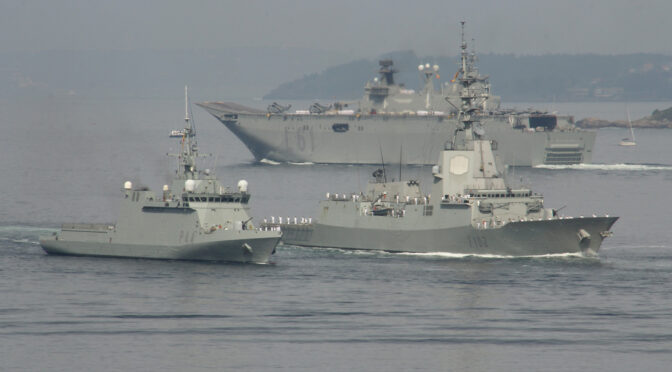By Gonzalo Vazquez
With an increasingly complex strategic environment, and a fleet struggling to meet its many operational requirements, the next CNO must strive to find new ways to capitalize on allied naval capabilities to succeed at sea. Prominent options include strengthening naval cooperation with partners to ensure a permanent presence in all strategically relevant theaters, and bolstering the sharing of naval knowledge among allied naval war colleges.
Although significantly smaller in size and capabilities, European navies remain valuable assets that help Washington avoid a thinly-stretched force posture. Current NATO standing naval forces provide relatively low-cost means of sending high-value political signals of unity and forward deployments of warfighting capability. These standing naval forces could help strengthen Allied presence in the Mediterranean, the North Atlantic, or the Baltic Sea regions.
Mediterranean countries´ navies field strong assets and are capable of providing a sustained presence throughout the region, as do the navies of Canada, Denmark, Norway and the U.K. in the North Atlantic and the High North. The CNO must look for new ways to maximize the help they can offer, such as by improving their interoperability under the framework of Standing NATO Maritime Groups (SNMGs). This interoperability can be enhanced by linking centers of excellence that focus on tactical and training development, so that navies can share warfighting lessons across allied fleets.
The U.S. should also capitalize on the growing capabilities of the Japanese and South Korean navies to face China in the Indo-Pacific region. Their commercial shipbuilding industrial bases have made them the second and third largest in the world by numbers, only behind Beijing. These capabilities could be leveraged to improve logistics and repair capacity. As such, they bring promising opportunities in a contested region and can help offset the relative lack of shipbuilding capacity in the United States.
With them, Australia and the Philippines will also be important assets to drive a credible deterrent posture against China´s growing assertiveness. Hybrid tactics in the vicinity of the South China Sea, like the water cannon incident in August 2023, could be handled better by using something similar to a Standing Maritime Group framework but applied in the Indo-Pacific. The partnership announced by Washington and Manila to enhance their surveillance around the region is a good starting point, but the CNO must aspire to include other regional partners as well.
Additionally, for stronger support to Allied efforts at sea, cooperation and sharing of expertise among partner nations at the academic level is highly desirable. Options worth considering include bringing qualified allied observers to sea to witness combat exercises at higher levels of classification, and establishing a formal network of the different naval war colleges to share knowledge, wargames, and curriculum.
The conference of PLAN admirals in 2022 highlighted China’s aspirations to expand their research on military affairs and study their adversaries in detail. Beijing is aware of the vital role that academic research plays in improving chances of warfighting success at sea, and so should allied navies. The new CNO will be in an excellent position to advocate for new joint initiatives among allied naval war colleges.
Admiral J.C. Wylie spoke of the need for naval presence, that a “man on the scene with a gun [may be needed] to exercise the durable and continuing control that can rarely be had in any other way.” Allied navies are poised to be on the scene and provide tangible presence. The new CNO must drive the U.S. Navy into a new chapter of Allied naval cooperation.
Gonzalo Vázquez is a junior analyst with the Center for Naval Thought at the Spanish Naval War College, and is currently working as an Intern at the Crisis Management and Disaster Response Center of Excellence in Sofia, Bulgaria.
Featured Image: Naval review of the Spanish Navy held on June 2, 2017 in the Pontevedra Estuary on the occasion of the 300th anniversary of the Royal Company of Guardiamarinas, origin of the current Naval Military Academy of Marín. In the picture, BAM Tornado P-44, frigate Almirnate Juan de Borbón F-102 and Juan Carlos I aircarrier. (Photo via Wikimedia Commons)

